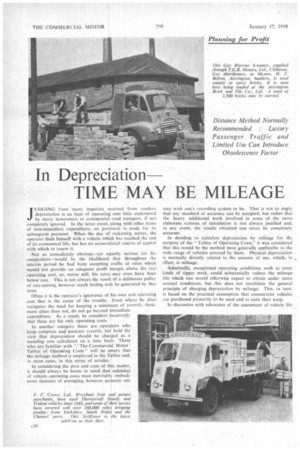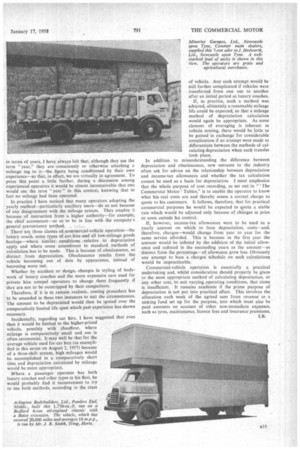In Depreciation TIME MAY BE MILEAGE
Page 70

Page 73

If you've noticed an error in this article please click here to report it so we can fix it.
JUDGING from -Many inquiries received from readers, depreciation is an item of operating cost little understood by many newcomers to commercial road transport. if not completely ignored. In the latter event, along with other items of non-immediate expenditure. no provision is made for its
, subsequent payment. When the day of reckoning comes, the operator finds himself with a vehicle which has reached the end of its economical life, but has no accumulated reserve of capital with which to renew it.
Not so immediately obvious—yet equally serious for his competitors—would he the likelihood that throughout the interim period he had been accepting trunk at rates which would not provide an adequate profit margin above his real operating cost, or, worse still, his rates may even have been below cost. This is not always the result 'of a deliberate policy of rate-cutting, however much feeling fluty be generated by that term.
Often it is the operator's ignorance of his own real operating cost that is the cause of the trouble. Even where he does recognize the need for keeping a minimum of records. these. more often than not, do not go beyond immediate expenditure. As a result, he considers incorrectly that these are his only operating costs. .
In another category there arc operators who keep complete and accurate records. but hold the view that depreciation should he charged as a standing cost calculated on -a time basis. Those who are familiar with " ' The Commercial Motor ' Tables of Operating Costs" will be Aware that the mileage method is employed' in the Tables and. in most cases, in this series. of articles.
' In considering.the pros and cons of this matter, it should always be -borne in mind that estimate's of vehicle operating costs must inevitably embody some measure of averaging, however accurate one may wish one's recording system to be. That is not to imply that any standard of accuracy can be accepted, but rather that the heavy additional work involved in some of the more elaborate systems of calculation is not always justified and, in any event, the results obtained can never be completely accurate.
In deciding to calculate depreciation by mileage for the purpose of the "Tables of Operating Costs," it was considered that this would be the method most generally applicable to the wide range of vehicles covered by them. Physical depreciation is normally directly related to the amount of use, which, in effect, is mileage.
Admittedly, exceptional operating conditions, such as sonic kinds of tipper work, •could substantially reduce the mileage life which one would otherwise expect to obtain under more normal conditions, but, this does not invalidate the general principle of charging depreciation by mileage. This, in turn. is based on the practical assumption that commercial vehicles are purchased primarily to be used and to earn their keep.
In discussion with advocates of the assessment' of vehicle life
in terms of years, I have always felt that, although they use the term "year," they are consciously or otherwise attaching a mileage tag to it—the figure being conditioned by their own experience—so that, in effect, we are virtually in agreement. To press this point a little further, during a discussion among experienced operators it would be almost inconceivable that one would use the term " year " in this context, knowing that in fact no mileage had been operated.
In practice I have noticed that many operators adopting the yearly method—particularly ancillary users—do so not because of any disagreement with the mileage system. They employ it because of instruction from a higher authority—for example, the chief accountant—so as to be in line with the company's general accountancy method.
There are three classes of commercial-vehicle operation—the luxury coach, some types of car hire and all low-mileage goods haulage—where similar!r, conditions relative to depreciation apply and where some amendment to standard methods of calculation has to be made. This is because of obsolescence, as distinct from depreciation. Obsolescence results from the vehicle becoming out of date by appearance, instead of becoming worn out.
Whether by accident or design,changes in styling of bodywork of luxury coaches and the more expensive cars used for private hire compel operators to change them frequently if they are not to be outstripped by their competitors.
Therefore, if it is to remain realistic, costing procedure has to be amended in these two instances to suit the circumstances. The amount to be depreciated would then be spread over the comparatively limited life spari which past experience has shown necessary. Incidentally, regarding car hire, I have suggested that even then it would be limited to the higher-priced vehicle, possibly with chauffeur, where mileage is comparatively small and use is often ceremonial. It may well be that for the average vehicle used for car hire (as exemplified in this series on August 2, 1957) because of a three-shift system, high mileages would be accomplished in a comparatively short time and depreciation calculated by mileage would be more appropriate.
.Where a passenger operator has both luxury coaches and other types in his fleet, he would probably find it inconvenient to try to use both methods, according to the class of vehicle. Any such attempt would be still further complicated if vehicles were transferred from one use to another after an initial period as luxury coaches.
If, in practice, such a method was adopted, ultimately a reasonable mileage life could be expected, so that a mileage method of depreciation calculation would again be appropriate. As some element of averaging is inherent in vehicle costing, there would be little to be gained in exchange for considerable complication if an attempt were made to differentiate between the methods of calculating depreciation when each transfer took place.
In addition to misunderstanding the difference between depreciation and obsolescence, new entrants to the industry often ask for advice on the relationship between depreciation and income-tax allowances and whether the tax calculation cannot be used as a basis for depreciation. I must emphasize that the whole purpose of cost recording, as set out in " 'The Commercial Motor' Tables," is to enable the operator to know what his real costs are and thereby assess a correct charge to quote to his customers. It follows, therefore, that for practical commercial purposes he would be expected to quote a stable rate which would be adjusted only because of changes in price or costs outside his control.
If, however, income-tax allowances were to be used as a yearly amount on which to base depreciation, costs—and, therefore, charges—would change from year to year for the same service afforded. This is because in the first year the amount would be inflated by the addition of the initial allowance and reduced in the succeeding years as the amount—as 'distinct from the percentage—of allowance grew less. Obviously any attempt to base a charges schedule on such calculations would be impracticable.
Commercial-vehicle operation is essentially a practical undertaking and, whilst consideration should properly be given to the most appropriate method of calculating depreciation, or any other cost, to suit varying operating conditions, that alone is insufficient. It remains academic if the prime purpose of depreciation is not put into practical effect. This involves the allocation each week of the agreed sum from revenue to a sinking fund set up for the purpose, into which must also be paid amounts on account of other non-immediate expenses, such as tyres, maintenance, licence fees and insurance premiums.
















































































































